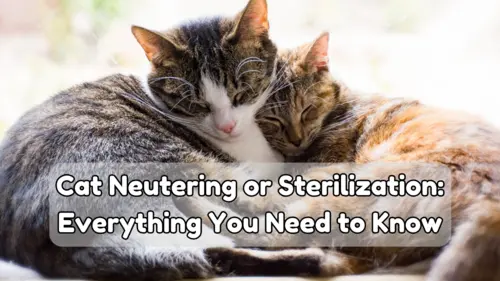
Admin / 6 -September -2023 – Cat Neutering or Sterilization: Everything You Need to Know
Cat sterilization is a common medical procedure performed to control feral cat populations and manage pet cat populations. In addition, sterilization also has health benefits for your cat. This article will explain the right time for cat sterilization, the benefits of sterilization, the cat sterilization procedure, as well as the care required after the surgery.
The Right Time for Cat Sterilization:
Cat sterilization can be performed at various stages in a cat’s life, but there are times that are considered the most appropriate to perform the procedure:
- 6 months of age: Feline sterilization is often performed when cats reach 6 months of age. By this age, cats have usually reached sexual maturity and can breed. Sterilization at this age can prevent unwanted population growth.
- Before Puberty: Typically, a sign that a female cat has reached puberty is when she begins to meow louder, while a sign that a male cat is in heat is when he tends to urinate indiscriminately to mark his territory or begins prowling around in an attempt to mate.
Benefits of Cat Sterilization:
- Population Control: Sterilization prevents the growth of feral cat populations that often suffer from starvation and disease. By reducing the number of cats born, we can help solve this problem.
- Reduces Disease Risk: Sterilised cats have a lower risk of developing infectious diseases such as FIV (Feline Immunodeficiency Virus) and FeLV (Feline Leukaemia Virus), which can often be transmitted through sexual contact.
- Behavioural Changes: Sterilization can reduce unwanted behaviours in cats, such as roaming, territorial marking, and mating attempts. This can make your pet cat calmer and more comfortable.
- Reduced Cancer Risk: Unneutered female cats have a higher risk of developing ovarian and breast cancer. In male cats, sterilization can reduce the risk of testicular cancer.
Cat Sterilization Procedure:
Cat sterilization is a routine operation usually performed by a veterinarian. Here are the steps of the sterilization procedure:
- Surgery: The cat is given a general anesthetic, and the vet surgically removes the reproductive organs (ovaries in females and testicles in males). This renders the cat unable to breed.
- Monitoring: Once the surgery is complete, the cat will be monitored to ensure a good recovery before being allowed to go home.
- Post-Surgery Care: Once your cat has undergone sterilization, post-operative care is essential. This includes administering any painkillers prescribed by the vet, keeping the cat in a calm environment, and ensuring they do not lick or scratch the surgery site.
Post-Surgery Care:
- Avoiding Excessive Physical Activity: Ensure your cat does not engage in excessive physical activity during the recovery period, such as jumping or playing.
- Surgical Scar Care: Check the surgical site regularly to ensure there are no signs of infection. If you notice signs of infection such as redness, swelling or discharge, consult your vet immediately.
- Food and Drink Monitoring: Make sure your cat is eating and drinking well after surgery. If they refuse to eat, contact your vet immediately.
Conclusion:
Cat sterilization is an important step in controlling the cat population and keeping your pet cat healthy. The appropriate time for sterilization is around 6 months of age or before the cat enters puberty. The procedure is relatively simple, but good post-operative care is essential. By sterilization at the right time, you can give your beloved cat a healthier life and help solve the feral cat population problem. Feel free to consult your veterinarian for more information on cat sterilization.
